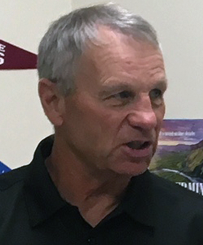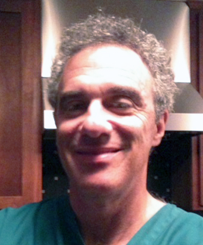
AHEC STORIES
Jonathan Calles
With CEAHEC’s help, I was offered an opportunity to job shadow at a hospital, hear guest speakers talk about their health care careers, and get a hands-on patient care experience using a manikin, as well as explore a variety of medical professionals at MedStars camp in July. All this inspired me to become a flight nurse and pursue a master’s degree in nursing.
A step I have taken toward that goal is to complete the Certified Nurse Assistant training before graduating high school. CEAHEC awarded me two scholarships, and this allowed to me to begin the CNA2 class immediately after high school and to seek employment at St. Charles Health System.
My plan is to work as a CNA2 and attend COCC as I work toward getting into the nursing program. I know that all the hard work, sacrifices, and adjustments I will make in my life, will pay off and allow me to become a healthcare professional.
If you are interested in helping others, working in a team environment, and having a great career in health care, CEAHEC can help to get you there. My advice to students who are still in high school or about to graduate would be, the most important thing to achieve your goals is to not be afraid. Don't be afraid of all the work, don't be afraid of the financial and economic factors, the problems you may encounter, or the confusion of all the careers you can choose from. Most importantly, never be afraid to ask for help. CEAHEC is a great resource for anyone interested in entering a healthcare career.
Kurt Davis
Without Kurt Davis, Career and College Advisor at Culver High School, there would be no job shadowing program for central Oregon high school students. As a teacher, counselor and coach in the late 1990s at Redmond High School, Kurt had the idea of introducing Redmond students to the wide variety of health care careers through job shadowing. The Central Oregon District Hospital- not yet a part of the St. Charles system- enthusiastically embraced the idea and the hospital and caregivers have been staunch supporters of the program since.
Most of the high school students who Kurt has recruited for this opportunity have gone on to college and are serving in a wide variety of health care professions. In his current role at Culver High School, he carefully selects the students who will participate. Most of his students may be the first in their families to graduate from high school and go on to college. He combines support, inspiration and accountability in his relationships with students.
Kurt once remarked “There is no better way to understand the potential in health care careers than to walk in the shoes of a wide selection of caregivers. These students get a real sense of the job- the best parts and the difficult parts.”
In 2014, Kurt had knee replacement surgery at St. Charles, Bend. Upon awaking from the anesthesia, he recognized three of his caregivers as former students. “If anyone wonders if this program works, those nurses in my hospital room were living proof.”
Kurt and his wife, Maureen, live in Culver and are valuable community members. One of their three sons, Kris- has succeeded Kurt at Redmond HS, insuring the continuation of this opportunity for Redmond HS students. Kurt’s plan is to keep working with “motivated kids to encourage our best and brightest to enter the medical profession.”
Samantha Nelson
I’m a college student planning to pursue a career in nursing. What initially drew me to this career was a class I had the opportunity to take in high school called Health Occupations. Through this class I was able to job shadow at St. Charles Medical Center and have the opportunity to rotate to each department. This not only gave me a chance to experience multiple aspects of a hospital, but it also showed me how the staff members interact with each other to form a team. This class helped me figure out a career that I am passionate about pursuing, and also inspired me take risks. Through this class I was also given the opportunity to attend a summer internship camp known as HPREP, which was held at OHSU in Portland.
I had an amazing experience participating in many hands-on medical activities, interacting with various health care professionals and learning about career opportunities and the skills required for a career in the medical field. I was then able to give back as a counselor for the MedStars camp two years later and share my own personal experiences with high school students, who are also interested in pursuing a healthcare career. All of these various activities I was able to be a part of would not have been possible without the help of CEAHEC and I am forever grateful for their support. CEAHEC also provided me with a scholarship to help pay for some of my schooling expenses, which will help me achieve my goal of acquiring my BSN degree.
After I graduate I plan to practice somewhere in rural Oregon. Working in a rural area means that I will have the opportunity to build closer relationships with my patients which is something I really value. Another aspect that drew me to the idea of serving in a rural community is the overall freedom I would have with my job. This freedom will allow me to spend more time with each individual patient and really develop a relationship with them and a better understanding of their medical needs. I think this type of direct patient contact can be lost in larger hospitals and cities and it's something I really value as a future healthcare provider.
Rick Tietz
As a practicing ER physician in Central Oregon, I enjoy working with a diverse, semi-rural population. I speak fluent Spanish and frequently converse with Spanish speaking patients. I am hugely grateful to the Spanish community, as our two children were adopted from Central America.
While in Lake Tahoe, I started a free clinic to provide health care for those without health insurance. During that time, we treated many Hispanics, who seemed to sincerely appreciate our efforts.
Fast forward to now, where after three decades in ER practice, I realize the huge need for more minorities in health care. I began working with Debbie Cole and AHEC to help with their minority outreach efforts. I participate in Diagnosis Days, where students are given the opportunity to interact with various health care professionals. My goal is to stimulate interest so that these students may one day follow a career path in health care.
I have recruited one of our talented bilingual Hispanic nurses, Ana, who often accompanies me to these talks. We are also both involved in the Immigration Solidarity Network, which works closely with local Dreamers.
AHEC offers me and others like me an invaluable opportunity to pursue goals of increasing minority healthcare recruitment. Starting at a young age is a big advantage.




